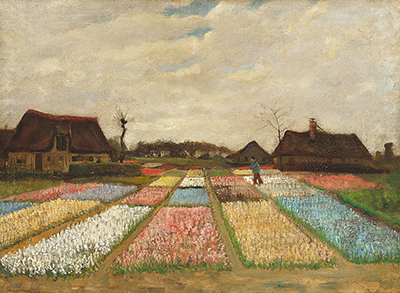Bulb Fields is an oil painting created by the Dutch artist, Vincent van Gogh in early 1883. The painter painted the piece of art during his second year in The Hague and it was his very first painting, in oil paint on canvas attached on wood.
Also called Flower Beds in Holland, the painting depicts the rectangular fields of pink, red, yellow and blue hyacinths planted by a Dutch merchant. The foreground of his composition and the low vantage point seem to rise sharply, creating a panoramic view of the plantation filled with bright flowers, with bare tree trunks and thatched cottages engulfed in a somber shadow. This background creates a striking contrast to the colourful flowers in the fields. This composition, together with tonal contrast and raked perspective, persisted in Van Gogh’s paintings of landscapes.
Oscar-Claude Monet, the founder of French Impressionist painting, was very impressed by the bright colours used in the Flower Beds in Holland painting. He even wrote a letter to a friend, in the early spring of 1886, saying that the sight was "difficult to convey with our poor colours." The French painter had been to the Netherlands before but was painting a garden full of flowers for the first time.
Van Gogh was so passionate about gardens and most of his works focused on the theme of agriculture. Some of his paintings that have a similar theme include Sunflowers, Wheatfield with Crows and Dr Gachet's Garden in Auvers. It is likely that Vincent van Gogh left Bulb Fields with other early works in Nuenen where his family lived during his departure for Antwerp in late 1885. His recently mother and sister Willemina moved to Breda with the painting in early 1886. With other household items, the painting was stored by a neighbourhood carpenter, Adrianus Schrauwen. While not the legal owner, the Breda carpenter sold the painting along with other items to a merchant by the name J.C. Couvreur in 1902.
J.C. Couvreur then swiftly passed the items to a military clothing dealer known as Kees Mouwen, who seemed to have co-owned them with Willem van Bakel. From here, they were entrusted to Mrs. Oldenzeel, who exhibited the painting in 1902 in Rotterdam at the Kunstzalon Oldenzeel under the title Tulpenland (Dutch: "Tulip fields"). The painting was later sold to Jan Smit in 1905 who passed it down to John Enthoven, who was his grandson in 1919. Flower Beds in Holland passed through the hands of several dealers before it was bought by Paul Mellon in 1955 from the Knoedler gallery. In 1983, Mellon donated the piece of art to the National Gallery Art in Washington DC.




